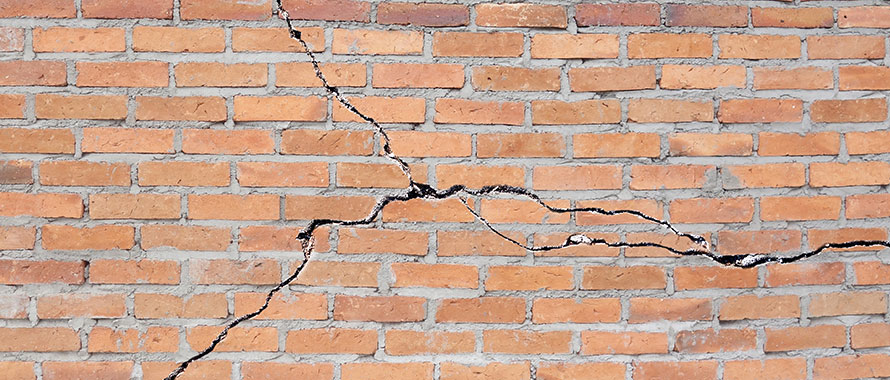On July 5, approximately 125 miles northeast of Los Angeles in Ridgecrest, California residents experienced a 7.1-magnitude earthquake, only 34 hours after a 6.4-magnitude earthquake shook the same location. Fortunately, there were no deaths. As homeowners and businesses evaluate damage, early estimates predict at least $100 million in losses.
California is the site of more than 500 active geological faults, and scientific research has put the likelihood of a 6.7-magnitude or greater earthquake within the next 30 years at more than 99 percent. Yet many residents do not have Earthquake Insurance. By law, homeowners in California must be offered Earthquake Insurance, with a renewal of the offer every other year, however there is no legal requirement for homeowners to purchase the insurance. Most recent data shows in 2017, only 13.29 percent of California residences had Earthquake coverage, though the actual percentage of residents with coverage may be even lower, as this data does not account for the uninsured.
“Earthquake Insurance is available to everyone,” explained Sylvia Ornelas, Director, Personal Insurance, Burns & Wilcox, Los Angeles, California. “Homeowners need to be aware of that and talk to their insurance brokers and agents to ensure that they are fully protected.”
The toll of earthquakes
Historically, earthquakes have rattled California with disastrous results. “With earthquakes, devastations are a lot worse than with any other peril,” Ornelas said. Earthquakes can disrupt necessary services including electricity, water and sewer. Damage usually corresponds to an earthquake’s magnitude, though it also depends on where the earthquake happens. A 6.7-magnitude earthquake in Northridge, California, in 1994 that killed 61 and caused $15 billion in damage was weaker than this month’s strongest tremblor but was centered in a more populous area, and thus resulted in more damage.

People do not realize that with earthquakes, devastations are a lot worse than with any other peril.
Earthquakes can occur in most of the U.S. and around the world. 81 percent of Earth’s largest quakes happen on the circum-Pacific seismic belt, which runs along the rim of the Pacific Ocean and touches, among other areas, both the U.S. and Canada. On July 3, a day before the California earthquake, a 6.2-magnitude earthquake hit off the shore of British Columbia, part of a series that has both Canadians and Californians concerned about “the big one.” A 9.0-magnitude quake has long been predicted in this area of Canada, as it has been the site of major earthquakes, with one in 1700 estimated to be approximately 9.0-magnitude and known to have caused tsunamis in Japan.
Canada is similar to California in terms of residential Earthquake coverage. “Most homeowners policies do not offer the coverage,” explained Tyson Peel, Director, Property and Casualty, Burns & Wilcox, Toronto, Ontario. In Canada, there is also no legal requirement that homeowners are offered this insurance. However, homeowners can purchase Earthquake coverage separate from their homeowners policies. Even so, residents of earthquake-prone areas in Canada, like those in the U.S., do not always take advantage, Peel explained. Quebec, an earthquake zone, has only a 3.4 percent uptake on Earthquake coverage, while British Columbia, site of the most recent quakes, has a 60 percent uptake rate, he said.
Are you covered?
In 1996, in the aftermath of the Northridge earthquake’s destruction, the California legislature created the California Earthquake Authority (CEA), dedicated to helping Californians protect themselves through Earthquake Insurance, mitigation and education. The insurance can be crucial; homeowners without it are responsible for all repairs and rebuilding, as well as costs to live and eat elsewhere, both in the U.S. and Canada.
Even if an earthquake is a major disaster, that does not mean that homeowners and businesses will receive government assistance. Government assistance, in any case, is often confined to low-interest loans, which must be repaid. Earthquake Insurance will typically cover most of the damage from an earthquake and may also include replacing the damaged contents of a home, repairing other buildings, like garages, and covering the cost of temporarily living elsewhere.
Business protection
While CEA has helped ensure that Earthquake Insurance is offered to all California homeowners, it does not provide a similar function to businesses. In fact, only 10 percent of businesses in California have Earthquake Insurance coverage, even though they face significant risk.
“Just like a fire loss, without insurance, the risk of being put out of business due to serious damage is very high,” explained Samantha Johnson, Broker, Burns & Wilcox, Los Angeles, California. “Earthquake Insurance is excluded in most standard property policies, and earthquake damage can take a long time to repair due to increased demand for materials and labor after a natural disaster. Even a modest property loss can take a significant amount of time to get fixed.”
Just like a fire loss, without insurance, the risk of being put out of business due to serious damage is very high.
For businesses that want Earthquake coverage but are looking for ways to reduce the cost, Johnson suggested taking on a higher deductible to help lower the premium. Additional steps can reduce both insurance and repair costs, such as retrofitting the premises to make them earthquake resilient and mandating off-site duplication of electronic records and key inventory so that one hub can continue if the other is damaged, Johnson said.
Johnson also suggested that businesses speak with their insurance broker or agent. “A knowledgeable broker can help determine an adequate replacement cost valuation as opposed to a real estate market value,” Johnson said, noting that insurers need to have a clear sense of what true replacement will cost to provide useful coverage. “A broker can also help you navigate the murky waters of a Business Income Worksheet to help determine adequate limits for the time element components. Inadequate time element limits could be detrimental to many businesses following substantial property losses.”
Misconceptions and solutions
Residents of earthquake-prone areas often attribute their reluctance to purchase Earthquake Insurance to high premiums and the unlikeliness of an event. Insurers and the CEA have been working hard to address these misconceptions. Since the creation of the CEA, premiums have decreased by 50 percent. Insurers have also created options to address costs, including the “mini,” which offers lower-cost, pared-down coverage. “The mini can cover your dwelling, along with $5,000 for contents, and $1,500 for loss of use,” Ornelas said.
Another option is a buyback deductible, which allows an insurance buyer to reduce or completely eliminate their deductible by paying a higher premium. This can make a lot of sense for larger, more expensive homes, explained Heather Posner, Associate Vice President and Director, Private Client Practice, Burns & Wilcox. “If you have a 25 percent deductible on a $10 million home, that is a substantial deductible,” Posner said. A deductible buyback would allow a person in that situation to get a 5 percent or a 10 percent deductible for a premium. As with other insurance questions, talk with your broker or agent. “A lot of carriers will get creative with you to help,” Ornelas said. “There are a lot of options available to help minimize the costs.”

There is a 99 percent chance that California will have an earthquake 6.3 or higher in the next 30 years.
Retrofitting and other safety preparations can help reduce costs for homes as well as businesses. Recommendations include having the appropriate braces in place, strapping water heaters in place, and having a seismic gas shut-off device. Companies specializing in retrofitting will often come and make recommendations for free or for a low fee.
As for the idea that a big earthquake is unlikely, Posner said, “There is a 99 percent chance that California will have an earthquake 6.3 or higher in the next 30 years.” To put that time in context, she suggests homeowners think about their mortgages. “If your mortgage is 30 years, there is a good chance that you may need this coverage.”
Looking to the future
The most recent earthquake is fresh in our minds, but that sense of urgency may fade. It should not; the risk of earthquake remains the same for the region over time. “It is a hard thing to purchase coverage that is not required,” Posner said. “But when you consider that most people’s largest asset is their home, and in the event of an earthquake there is a high potential that there will be damage, it really is important coverage.”
This is true for businesses as well. “Earthquake coverage is readily available, and inexpensive compared to the cost of repair,” Johnson said. “Earthquakes strike with no warning and cannot be predicted. Insurance is a useful means of transferring the unknown potential of a huge financial loss in exchange for a much smaller known loss — the premium.”






